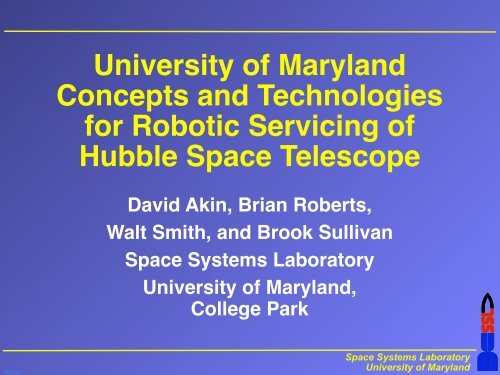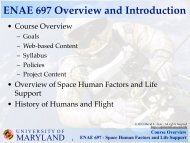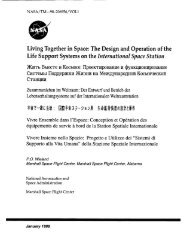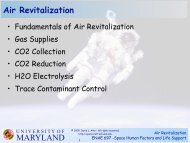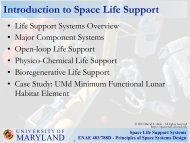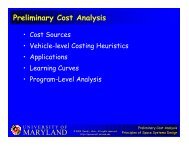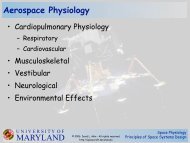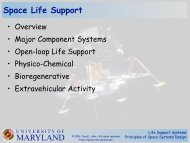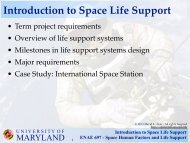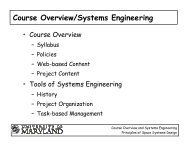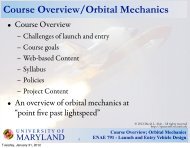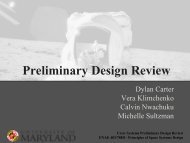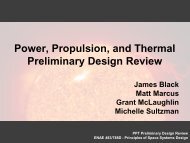PDF - University of Maryland
PDF - University of Maryland
PDF - University of Maryland
Create successful ePaper yourself
Turn your PDF publications into a flip-book with our unique Google optimized e-Paper software.
test.col.pp4<br />
<strong>University</strong> <strong>of</strong> <strong>Maryland</strong><br />
Concepts and Technologies<br />
for Robotic Servicing <strong>of</strong><br />
Hubble Space Telescope<br />
David Akin, Brian Roberts,<br />
Walt Smith, and Brook Sullivan<br />
Space Systems Laboratory<br />
<strong>University</strong> <strong>of</strong> <strong>Maryland</strong>,<br />
College Park<br />
Space Systems Laboratory<br />
<strong>University</strong> <strong>of</strong> <strong>Maryland</strong>
test.col.pp4<br />
Presentation Overview<br />
• Space Systems Laboratory background<br />
• Relevant SSL technologies<br />
• Ranger: system and experiences<br />
• Recent HST studies<br />
• Mission concepts<br />
• Conclusions<br />
Space Systems Laboratory<br />
<strong>University</strong> <strong>of</strong> <strong>Maryland</strong>
test.col.pp4<br />
ARAMIS Telerobotics Study<br />
Survey <strong>of</strong> five NASA “Great Observatories” to<br />
assess impacts and benefits <strong>of</strong> telerobotic<br />
servicing - major results:<br />
• Ground-controlled telerobotics is a pivotal<br />
technology for future space operations<br />
• Robotic system should be designed to perform<br />
EVA-equivalent tasks using EVA interfaces<br />
– Maximum market penetration for robot<br />
– Maximum operational reliability<br />
– Designing to EVA standards well understood<br />
• Fully capable robotic system needs to be able to<br />
do rendezvous and proximity operations,<br />
grapple, dexterous manipulation<br />
Space Systems Laboratory<br />
<strong>University</strong> <strong>of</strong> <strong>Maryland</strong>
test.col.pp4<br />
Fundamental Concept <strong>of</strong> Robotic Servicing<br />
Human Workload<br />
Issues?<br />
Control Station<br />
Design?<br />
Manipulator<br />
Design?<br />
Ground Control?<br />
Flexible Connections<br />
to Work Site?<br />
Multi-arm Control and<br />
Operations?<br />
Interaction with Nonrobot<br />
Compatible<br />
Interfaces?<br />
Utility <strong>of</strong><br />
Interchangeable<br />
End Effectors?<br />
Ground-based<br />
Simulation<br />
Technologies?<br />
Capabilities and<br />
Limitations?<br />
Hazard Detection and<br />
Avoidance?<br />
Development,<br />
Production, and<br />
Operating Costs?<br />
Effects and Mitigation<br />
<strong>of</strong> Time Delays?<br />
Space Systems Laboratory<br />
<strong>University</strong> <strong>of</strong> <strong>Maryland</strong>
test.col.pp4<br />
Beam Assembly Teleoperator<br />
Space Systems Laboratory<br />
<strong>University</strong> <strong>of</strong> <strong>Maryland</strong>
test.col.pp4<br />
SSL Relevant Experience Timeline (1)<br />
‘80 ‘81 ‘82 ‘83 ‘84 ‘85 ‘86 ‘87 ‘88 ‘89<br />
SSL studies applications<br />
<strong>of</strong> automation, robotics,<br />
and machine intelligence<br />
for servicing Hubble and<br />
other Great Observatories<br />
for NASA MSFC<br />
Initial operational<br />
tests <strong>of</strong> Beam<br />
Assembly<br />
Teleoperator<br />
Experimental<br />
Assembly <strong>of</strong><br />
Structures in EVA<br />
flies on STS 61-B<br />
BAT used for<br />
extensive<br />
servicing tests on<br />
HST training<br />
mockup<br />
SSL develops<br />
ParaShield<br />
flight test<br />
vehicle for<br />
suborbital<br />
mission<br />
Space Systems Laboratory<br />
<strong>University</strong> <strong>of</strong> <strong>Maryland</strong>
test.col.pp4<br />
Ranger Telerobotic Flight Experiment<br />
Space Systems Laboratory<br />
<strong>University</strong> <strong>of</strong> <strong>Maryland</strong>
test.col.pp4<br />
SSL Relevant Experience Timeline (2)<br />
‘90 ‘91 ‘92 ‘93 ‘94 ‘95 ‘96 ‘97 ‘98 ‘99<br />
SSL<br />
designs<br />
Ranger<br />
based on<br />
experience<br />
with HST<br />
servicing<br />
UMd NBRF opens<br />
NASA<br />
selects<br />
Ranger TFX<br />
as low-cost<br />
robotic flight<br />
experiment<br />
Ranger NBV<br />
operational<br />
Ranger performs<br />
end-to-end HST<br />
servicing simulations<br />
SSL directed to<br />
redesign<br />
Ranger for<br />
shuttle mission:<br />
Ranger TSX<br />
Phase 0<br />
PSRP<br />
RTSX<br />
PDR<br />
Space Systems Laboratory<br />
<strong>University</strong> <strong>of</strong> <strong>Maryland</strong><br />
RTSX<br />
CDR<br />
Phase 1<br />
PSRP<br />
Phase 2<br />
PSRP<br />
Environmental<br />
testing at JSC
test.col.pp4<br />
Ranger Neutral Buoyancy Vehicle I<br />
Space Systems Laboratory<br />
<strong>University</strong> <strong>of</strong> <strong>Maryland</strong>
test.col.pp4<br />
Ranger Telerobotic Shuttle Experiment<br />
Space Systems Laboratory<br />
<strong>University</strong> <strong>of</strong> <strong>Maryland</strong>
test.col.pp4<br />
SSL Relevant Experience Timeline (3)<br />
2000 2001 2002 2003 2004<br />
PXL in NB<br />
testing<br />
Development <strong>of</strong> ECU<br />
operations timeline<br />
All-up mockup for public<br />
outreach<br />
Ranger TSX<br />
program<br />
cancelled<br />
Dual-arm system in<br />
active test<br />
Modular<br />
miniature<br />
servicer<br />
development<br />
for DARPA<br />
Space Systems Laboratory<br />
<strong>University</strong> <strong>of</strong> <strong>Maryland</strong>
test.col.pp4<br />
Robotic HST Servicing - Batteries<br />
BAT (1987)<br />
RANGER (2003)<br />
Space Systems Laboratory<br />
<strong>University</strong> <strong>of</strong> <strong>Maryland</strong>
test.col.pp4<br />
Robotic HST Servicing - Instruments<br />
FGS<br />
ECU<br />
WFPC<br />
Space Systems Laboratory<br />
<strong>University</strong> <strong>of</strong> <strong>Maryland</strong>
test.col.pp4<br />
Ranger Flight Dexterous Arms<br />
Space Systems Laboratory<br />
<strong>University</strong> <strong>of</strong> <strong>Maryland</strong>
test.col.pp4<br />
Dexterous Arm Design Objectives<br />
• Approximately EVA-glove-sized end effectors with 30<br />
lbf capability and 30 lb-ft torque capability in any<br />
direction, and 45° per second joint velocities<br />
• Allow safe surface contact despite communications<br />
time delays requires active compliance-control loop<br />
closed onboard<br />
• Sufficient arm articulation for a wide range <strong>of</strong> tasks in<br />
a cluttered workspace<br />
• Allow exchange <strong>of</strong> specialized end effectors<br />
• Two mechanical tool drives to each end effector<br />
• For cooperative tasks, two arms with intersecting<br />
workspaces mounted on narrow base<br />
• Where feasible, additional sensors as alignment aids<br />
Space Systems Laboratory<br />
<strong>University</strong> <strong>of</strong> <strong>Maryland</strong>
test.col.pp4<br />
Dexterous Manipulator System Design<br />
Objectives Design Consequences<br />
Performance goals --- # <strong>of</strong> sensors, actuators --- # <strong>of</strong> wires<br />
Envelope requirements<br />
Reliability --- No external wiring<br />
Internal temperature monitoring<br />
Force/Torque sensing requirement<br />
Component temperature limits --- thermal analysis<br />
results<br />
Reliability, low maintenance<br />
Performance, low friction<br />
Thermal environment<br />
Component temperature limits --- thermal analysis<br />
results<br />
Serial communications,<br />
constant-length wiring<br />
through joint axes<br />
Short wiring runs<br />
for analog signals<br />
Brushless DC<br />
motors for arm<br />
actuation<br />
Internal heat sinks<br />
Aluminum and<br />
copper<br />
circumferential<br />
conductive paths<br />
Local<br />
processors for<br />
inner control<br />
loops<br />
Space Systems Laboratory<br />
<strong>University</strong> <strong>of</strong> <strong>Maryland</strong>
test.col.pp4<br />
Dexterous Manip System Design (cont.)<br />
Electrical Power<br />
limitations<br />
Thermal variation<br />
Thermal environment<br />
Objectives Design Consequences<br />
45-day nominal active design life without<br />
access for recalibration<br />
Control bandwidth goals<br />
Friction rejection<br />
Compliance Loop performance requirements --- stiff drive, no<br />
backlash<br />
Envelope<br />
requirements<br />
Unregulated Bus for<br />
high efficiency<br />
Joint-level control loops based on<br />
digital sensors to avoid analog drift<br />
and noise<br />
Co-located position<br />
sensors for high-gain inner<br />
joint loops<br />
Large<br />
harmonic<br />
drives<br />
Compliance Loop performance requirements --- high outer loop rate --- simple<br />
kinematics<br />
Contact stability requirements<br />
Task requirements --- ≥7 DOF (w/elbow pose)<br />
Envelope requirements<br />
Workspace requirements<br />
Current driver<br />
circuits rather<br />
than Voltage<br />
drivers<br />
Motors inside<br />
harmonic drives<br />
3 DOF intersecting<br />
axis shoulder<br />
4 DOF intersecting<br />
axis wrist<br />
1 elbow pitch w/<br />
<strong>of</strong>fset<br />
Space Systems Laboratory<br />
<strong>University</strong> <strong>of</strong> <strong>Maryland</strong>
test.col.pp4<br />
4-Axis Skew Wrist Design<br />
Space Systems Laboratory<br />
<strong>University</strong> <strong>of</strong> <strong>Maryland</strong>
test.col.pp4<br />
Wrist Roll<br />
Drive (aft)<br />
Why a Skew Axis?<br />
• Lower interference <strong>of</strong> the tool with the<br />
forearm extends pitch travel<br />
• Single-sided support <strong>of</strong> the inner wrist<br />
allows for greater yaw range<br />
• Frontal area <strong>of</strong> the wrist reduced by<br />
skew layback <strong>of</strong> pitch actuator<br />
Orthogonal 4-axis<br />
Yaw Drive<br />
Pitch Drive<br />
Hand Roll &<br />
Tool Drives<br />
Wrist Roll<br />
Drive (aft)<br />
Skew 4-axis<br />
Pitch Drive<br />
Yaw Drive<br />
Wrist Roll &<br />
Tool Drives<br />
Space Systems Laboratory<br />
<strong>University</strong> <strong>of</strong> <strong>Maryland</strong>
Pitch<br />
test.col.pp4<br />
180°<br />
135°<br />
90°<br />
45°<br />
0°<br />
-45°<br />
-90°<br />
-135°<br />
-180°<br />
Wrist Workspace Evolution<br />
3-DOF Wrist<br />
-180° -135° -90° -45° 0° 45° 90° 135° 180°<br />
Yaw<br />
Yaw, Wrist Roll, Hand Roll<br />
Pitch<br />
180°<br />
135°<br />
90°<br />
45°<br />
0°<br />
-45°<br />
-90°<br />
-135°<br />
-180°<br />
-180° -135° -90° -45° 0° 45° 90° 135° 180°<br />
- Workspace<br />
Orthogonal 4-DOF Wrist<br />
Yaw<br />
- Tool aligned with second link<br />
Yaw, Wrist Roll<br />
Yaw<br />
- Single singularity: redundancy lost in one or more axis;<br />
constrained axes are indicated<br />
- Double singularity; wrist drops to 2-DOF<br />
Hand Roll, Pitch<br />
Hand Roll, Pitch<br />
Pitch<br />
180°<br />
135°<br />
90°<br />
45°<br />
0°<br />
-45°<br />
-90°<br />
-135°<br />
-180°<br />
Skew 4-DOF Wrist<br />
-180° -135° -90° -45° 0° 45° 90° 135° 180°<br />
Yaw<br />
Yaw, Wrist Roll<br />
Hand Roll<br />
Pitch<br />
Yaw<br />
Hand Roll<br />
Space Systems Laboratory<br />
<strong>University</strong> <strong>of</strong> <strong>Maryland</strong>
test.col.pp4<br />
φ (deg)<br />
1080<br />
720<br />
(deg)<br />
φ<br />
360<br />
0<br />
Toolspace Comparison<br />
skew RPYR<br />
orthogonal RPYR<br />
RPR<br />
0 45 90 135 180<br />
θ (deg)<br />
Space Systems Laboratory<br />
<strong>University</strong> <strong>of</strong> <strong>Maryland</strong>
test.col.pp4<br />
Wrist Yaw Axis<br />
Hand Roll Axis<br />
Slow Tool Axis<br />
Fast Tool Axis<br />
Dexterous Arm Cross-Section<br />
Wrist Camera<br />
Wrist Pitch Axis<br />
Elbow Roll Axis<br />
Force/Torque Sensor<br />
Wrist Roll Axis<br />
Elbow Pitch Axis<br />
Shoulder Pitch Axis<br />
Shoulder Roll Axis<br />
Space Systems Laboratory<br />
<strong>University</strong> <strong>of</strong> <strong>Maryland</strong>
test.col.pp4<br />
Inner Wrist (Exploded View)<br />
Space Systems Laboratory<br />
<strong>University</strong> <strong>of</strong> <strong>Maryland</strong>
test.col.pp4<br />
Bearing/Housing Design<br />
• Problem: Steel (α = 7 µin/in°F) bearing<br />
installed in Aluminum (α = 13.1 µin/in°F)<br />
housing. Over a wide temperature range<br />
the mismatch can cause the bearing to<br />
spin in housing or seize.<br />
• Solution: Install appropriately-sized Invar<br />
(α = 0.7 µin/in°F) sleeve between bearing<br />
and housing. Sleeve size is chosen taking<br />
into account elastic deformation <strong>of</strong><br />
bearing race, sleeve, and housing.<br />
Preload is provided by interference<br />
(shrink) fit <strong>of</strong> sleeve in housing.<br />
Space Systems Laboratory<br />
<strong>University</strong> <strong>of</strong> <strong>Maryland</strong>
Bearing Installed<br />
Directly in Housing<br />
test.col.pp4<br />
Bearing Design Example<br />
.250"<br />
Ø6.250"<br />
Aluminum 6061-T6<br />
Housing<br />
Invar Sleeve<br />
Kaydon KC055BD6C<br />
Ball Bearing<br />
.250"<br />
.082"<br />
Sleeve Installed<br />
Between Bearing<br />
and Housing<br />
Effect <strong>of</strong> Invar sleeve is to make bearing preload invariate with temperature<br />
Space Systems Laboratory<br />
<strong>University</strong> <strong>of</strong> <strong>Maryland</strong>
test.col.pp4<br />
Actuator Performance Summary<br />
Wrist Yaw<br />
Wrist Pitch<br />
Shoulder Roll Elbow Roll Hand Roll<br />
Shoulder Pitch Elbow Pitch Wrist Roll Slow Tool Fast Tool<br />
Motor RBE-02112A RBE-01812A RBE-01812A BMS-3302A RBE-01512B<br />
Ratio 101 101 61 120 1<br />
Torque (ft lb) 201 118 71 52 1<br />
No-load Vel (°/s) 56 101 168 139 15675<br />
Motor rpm (max) 948 1707 1708 2797 5225<br />
Space Systems Laboratory<br />
<strong>University</strong> <strong>of</strong> <strong>Maryland</strong>
test.col.pp4<br />
Dexterous Arm Parameters<br />
• Modular arm with co-located electronics<br />
– Embedded 386EX rad-tolerant processors<br />
– Only power and 1553 data passed along arm<br />
• 53 inch reach mounting plate-tool interface plate<br />
• 8 DOF with two additional tool drives (10<br />
actuators)<br />
• Interchangeable end effectors with secure tool<br />
exchange<br />
• 30 pounds tip force, full extension<br />
• 150 pounds (could be significantly reduced)<br />
• 250 W (average 1G ops)<br />
Space Systems Laboratory<br />
<strong>University</strong> <strong>of</strong> <strong>Maryland</strong>
test.col.pp4<br />
Design Loads<br />
• Nominal Operations; Structural Load Path<br />
– Fx, Fy, Fz: 300 lbf<br />
– Mx, My, Mz: 200 lb-ft<br />
• Actuator Input-side Loads (pure moment)<br />
– Shoulder Actuators: 650 oz-in<br />
– Elbow, Wrist Roll Actuators: 400 oz-in<br />
– Wrist Pitch, Yaw, Hand Roll, Slow Tool Actuators: 230 oz-in<br />
– Fast Tool Actuator: 240 oz-in<br />
• Actuator Output-side Loads (pure moment)<br />
– Shoulder Actuators: 200 lb-ft<br />
– Elbow Actuators: 120 lb-ft<br />
– Wrist Roll Actuator: 70 lb-ft<br />
– Wrist Pitch, Yaw, Hand Roll, Slow Tool Actuators: 50 lb-ft<br />
Space Systems Laboratory<br />
<strong>University</strong> <strong>of</strong> <strong>Maryland</strong>
test.col.pp4<br />
Design Loads (continued)<br />
• Collision Loads; External Housings<br />
– Maximal collision: 10 Joules (equivalent to 20 kg @ 1 meter/sec)<br />
– Method: assume kinetic energy converted to strain energy; find<br />
stresses for concentrated loading <strong>of</strong> component that produces<br />
the same strain energy<br />
• Launch and Landing Loads<br />
– Assume Stowed Configuration<br />
– Accelerations:<br />
– X: ± 7.9 G<br />
– Y: ± 4.9 G<br />
– Z: + 8.3 G, - 6.3 G<br />
– Subject to refinement with coupled-loads analysis<br />
• Consider additional loads in some cases:<br />
– Thermal ambient operational limits: -60° to +100° C<br />
– Assembly<br />
Space Systems Laboratory<br />
<strong>University</strong> <strong>of</strong> <strong>Maryland</strong>
test.col.pp4<br />
Generalized Inverse Kinematics<br />
WRIST JOINT<br />
ANGLES<br />
WRIST<br />
FORWARD<br />
KINEMATICS<br />
WRIST<br />
JACOBIAN<br />
MANIPULABILITY,<br />
JOINT LIMIT INDEX<br />
0<br />
RT J W<br />
ROTATIONAL<br />
CHANGE<br />
WRIST<br />
PSEUDOINVERSE<br />
JACOBIAN<br />
WRIST<br />
NULLSPACE<br />
JACOBIAN<br />
NULLSPACE<br />
VELOCITY<br />
0<br />
RT des<br />
Δr<br />
†<br />
J W<br />
0/<br />
JW r 0/<br />
HAND<br />
CONTROLLER<br />
φ,θ,ψ<br />
DESIRED<br />
TOOL<br />
ORIENATION<br />
Δθ p<br />
Δθ 0/<br />
+<br />
Δθ<br />
+<br />
W<br />
Space Systems Laboratory<br />
<strong>University</strong> <strong>of</strong> <strong>Maryland</strong>
test.col.pp4<br />
Singularity Avoidance (Experiment)<br />
Forearm rolls to avoid singularity<br />
0:13<br />
Space Systems Laboratory<br />
<strong>University</strong> <strong>of</strong> <strong>Maryland</strong>
test.col.pp4<br />
Interchangeable End Effector Mech.<br />
• 3 Mechanical Interfaces<br />
– Hand Roll Drive<br />
– Fast Tool Drive<br />
– Slow Tool Drive<br />
• No power or data<br />
interface<br />
Each IEEM is<br />
approximately<br />
2.75” Ø by 2”.<br />
Weight is 2 lbs.<br />
Space Systems Laboratory<br />
<strong>University</strong> <strong>of</strong> <strong>Maryland</strong>
test.col.pp4<br />
Interchangeable End-Effector Mechanism (IEEM)<br />
• Objectives<br />
– Permit teleoperated and possible autonomous tool changeout<br />
– Allow a rigid connection <strong>of</strong> Hand Roll DOF to tool structure<br />
– Allow a connection <strong>of</strong> two, Tool Drive actuators<br />
– Avoid introducing extra actuators or sensors<br />
– Minimize risk <strong>of</strong> tool detaching from DX Manipulator<br />
– Minimize risk <strong>of</strong> tool detaching from Tool Post<br />
– Package mechanism compactly<br />
» Minimize Tool/Wrist-center distance<br />
» Maintain clear Wrist Camera field <strong>of</strong> view<br />
» Maintain center shaft clear for boresight laser<br />
• Design Consequences: 5-State Mechanism<br />
– IEEM locked to Tool Post, back-driving blocked<br />
– DX Manipulator “S<strong>of</strong>t-Docked” to IEEM, IEEM locked to Tool Post<br />
– IEEM locked to both DX Manipulator and Tool Post<br />
– IEEM locked to DX Manipulator, “S<strong>of</strong>t-Docked” with Tool Post<br />
– IEEM locked to DX Manipulator, free from Tool Post, back-driving blocked<br />
Space Systems Laboratory<br />
<strong>University</strong> <strong>of</strong> <strong>Maryland</strong>
test.col.pp4<br />
IEEM Attached to Tool Post<br />
6 inches<br />
5<br />
4<br />
3<br />
2<br />
4<br />
0<br />
Space Systems Laboratory<br />
<strong>University</strong> <strong>of</strong> <strong>Maryland</strong>
test.col.pp4<br />
IEEM Exploded View<br />
Space Systems Laboratory<br />
<strong>University</strong> <strong>of</strong> <strong>Maryland</strong>
test.col.pp4<br />
State 1: IEEM Locked to Tool Post<br />
Tool Post<br />
Slotted Ring<br />
Blocking Latch<br />
Ball-Locks<br />
• Slotted Ring retains mushroom end <strong>of</strong> Tool Post<br />
• Two Ball-locks prevent ring rotation<br />
Space Systems Laboratory<br />
<strong>University</strong> <strong>of</strong> <strong>Maryland</strong>
test.col.pp4<br />
State 2: Manipulator Engages IEEM<br />
Manipulator teeth engaging<br />
Slotted Ring<br />
• Three teeth on Manipulator engage Slotted Ring<br />
• Two Ball-locks are released, permitting Ring rotation<br />
• Tool drives self-align and engage<br />
Ball-lock (Released)<br />
Space Systems Laboratory<br />
<strong>University</strong> <strong>of</strong> <strong>Maryland</strong>
test.col.pp4<br />
States 3, 4: Manipulator Rotates 60°<br />
Three Manipulator flanges<br />
engage IEEM flanges<br />
60°<br />
• State 3: Three flanges on Manipulator engage flanges on IEEM at<br />
beginning <strong>of</strong> rotation, locking Manipulator axially to IEEM<br />
• State 4: At end <strong>of</strong> rotation, mushroom end <strong>of</strong> Tool Post is free to<br />
disengage from IEEM<br />
Space Systems Laboratory<br />
<strong>University</strong> <strong>of</strong> <strong>Maryland</strong>
test.col.pp4<br />
State 5: Disengage Tool Post<br />
Blocking Latch<br />
(rotated)<br />
• Outward radial motion <strong>of</strong> Tool Post rotates Blocking Latch,<br />
preventing reverse rotation <strong>of</strong> Slotted Ring<br />
• When Tool Post is free, spring plunger in detent prevents<br />
back-rotation <strong>of</strong> Blocking Latch<br />
Space Systems Laboratory<br />
<strong>University</strong> <strong>of</strong> <strong>Maryland</strong>
test.col.pp4<br />
IEEM Bearing Design<br />
• Problem: Locking Collar has poor thermal<br />
contact with IEEM inner structure, since it<br />
is supported on ball bearings. If a large<br />
temperature difference develops, the<br />
bearings could seize.<br />
• Solution: Design contact angle <strong>of</strong><br />
bearings such that contact cones intersect<br />
on centerline <strong>of</strong> IEEM. Then any<br />
differential expansion <strong>of</strong> Locking Collar<br />
w.r.t. center structure occurs parallel to<br />
bearing contact, not affecting clearance or<br />
preload.<br />
Space Systems Laboratory<br />
<strong>University</strong> <strong>of</strong> <strong>Maryland</strong>
test.col.pp4<br />
Schematic <strong>of</strong> IEEM Bearings<br />
As Installed, Homogeneous<br />
Temperature<br />
Bearing Contact Cones<br />
Intersect on Centerline<br />
Locking Collar Contracted 2%<br />
(4000°F ΔT)<br />
No change in clearance<br />
Space Systems Laboratory<br />
<strong>University</strong> <strong>of</strong> <strong>Maryland</strong>
test.col.pp4<br />
Arm Side<br />
Wrist Camera View<br />
IEEM<br />
Tool Side<br />
Space Systems Laboratory<br />
<strong>University</strong> <strong>of</strong> <strong>Maryland</strong>
test.col.pp4<br />
Tool Drives<br />
• Tool Drive Motor Controllers are primary method<br />
for commanding / sensing EE gripping force or<br />
output torque<br />
• Tool Drive Motor Specifications<br />
– Hand Roll Drive (High Torque, Low Speed)<br />
– Slow Tool Drive (High Torque, Low Speed)<br />
– 52 ft-lbs, 139 °/s no load<br />
– Fast Tool Drive (Low Torque, High Speed)<br />
– 1 ft-lb, 15,675 °/s no load<br />
– Must add gearing to use<br />
Space Systems Laboratory<br />
<strong>University</strong> <strong>of</strong> <strong>Maryland</strong>
test.col.pp4<br />
End Effector Design Drivers<br />
• Structural / Mechanical Requirements<br />
– Grasp must be non-back-driveable<br />
– Factor <strong>of</strong> safety <strong>of</strong> 1.4 (Test) or 2.0 ( Analysis)<br />
– Withstand 300 lbs Force Along All Axes<br />
– Withstand 200 ft-lbs Moment About All Axes<br />
– Survive 6.75J Impact<br />
– Withstand Launch & Landing Loads<br />
– Meet NASA EVA contact spec<br />
– Meet RTSX Thermal Range<br />
• Operational<br />
– Visual Turn Indicators<br />
– Tool Color Should Contrast With Task Equipment (Not Black)<br />
– Visual Access for Grasp Verification<br />
– Neutral Buoyancy Compatible<br />
Space Systems Laboratory<br />
<strong>University</strong> <strong>of</strong> <strong>Maryland</strong>
test.col.pp4<br />
Bare Bolt Drive<br />
RTSX End Effectors<br />
Right Angle Drive<br />
Microconical<br />
End Effector<br />
Tether Loop<br />
Gripper<br />
EVA Handrail<br />
SPAR Gripper<br />
Gripper<br />
Space Systems Laboratory<br />
<strong>University</strong> <strong>of</strong> <strong>Maryland</strong>
test.col.pp4<br />
• Interfaces<br />
– 7/16” Hex Head Bolts<br />
– ECU Keyway Slot Bolts<br />
– APFR Latch Bolts<br />
• Characteristics<br />
• 5 lbs.<br />
• 12” x 3”ø<br />
• Status<br />
– NBV version in use<br />
Bare Bolt Drive (BBD)<br />
IEEM<br />
NBV<br />
Prototype<br />
Space Systems Laboratory<br />
<strong>University</strong> <strong>of</strong> <strong>Maryland</strong>
test.col.pp4<br />
Microconical End Effector (MEE)<br />
• Interfaces<br />
– RPCM Microconical Interface<br />
• Characteristics<br />
• 12 lbs. est.<br />
• 8” x 3”ø<br />
• Status<br />
– Drawings and Stress Analysis for EVA<br />
version received from OSS<br />
– IDEAS models completed<br />
– Not currently fabricated<br />
IEEM<br />
Microconical<br />
Interface<br />
Space Systems Laboratory<br />
<strong>University</strong> <strong>of</strong> <strong>Maryland</strong>
test.col.pp4<br />
• Interfaces<br />
– 7/16” Hex Head Bolts<br />
– ECU Connector Drive<br />
• Characteristics<br />
• 6 lbs.<br />
• 8” x 6” x 3”<br />
• Status<br />
– NBV version in use<br />
Right Angle Drive (RAD)<br />
IEEM<br />
NBV<br />
Prototype<br />
Space Systems Laboratory<br />
<strong>University</strong> <strong>of</strong> <strong>Maryland</strong>
test.col.pp4<br />
• Interfaces<br />
APFR Paddle Gripper (APG)<br />
– APFR Locking Collar<br />
– APFR Paddles<br />
– APFR Detent Levers<br />
• Characteristics<br />
– 9 Lbs.<br />
– 14” X 11” X 3”<br />
– PJM Based<br />
• Typical <strong>of</strong> parallel<br />
jaw mechanism<br />
flexibility for<br />
specialized<br />
interfaces<br />
IEEM<br />
Levers<br />
Paddles<br />
Collar<br />
Space Systems Laboratory<br />
<strong>University</strong> <strong>of</strong> <strong>Maryland</strong>
Tether<br />
Loop<br />
Gripper<br />
test.col.pp4<br />
Bare<br />
Bolt<br />
Drive<br />
Right<br />
Angle<br />
Drive<br />
Task Interfaces - ECU<br />
Electronic Controller Unit<br />
Space Systems Laboratory<br />
<strong>University</strong> <strong>of</strong> <strong>Maryland</strong>
test.col.pp4<br />
Task Interfaces - APFR<br />
Yoke<br />
Interfaces Include:<br />
1. Quarter Turn Rings (2)<br />
2. Latch Bolts (2)<br />
3. Lock Knob<br />
4. Yoke<br />
5. Detent Levers<br />
6. Locking Collar<br />
7. Paddles<br />
AQP<br />
BBD<br />
AQP<br />
TLG<br />
APG<br />
APG<br />
APG<br />
Plus use BBD to rotate APFR probe<br />
Space Systems Laboratory<br />
<strong>University</strong> <strong>of</strong> <strong>Maryland</strong>
test.col.pp4<br />
Ranger PXL System Requirements<br />
• Device to supply full 6 DOF mobility within a limited work<br />
volume<br />
• Force max: 25 lbf Torque max: 200 ft-lbf<br />
• Stiffness: 250 Klbf/rad Angular Speed max: 12º/sec<br />
• End point accuracy +/-.12”, precision .01”<br />
• Provide means to react loads generated by Ranger<br />
performing task duties while minimizing overall deflection<br />
• Design to maximize natural frequency <strong>of</strong> device with a target<br />
minimum <strong>of</strong> 10 Hz<br />
• Capable <strong>of</strong> reacting 580 ft-lbf torque due to Primary<br />
Reaction Control System firings (PRCS)<br />
• Brakes engage when no power is supplied<br />
• Brakes must have manual (EVA) over-ride<br />
• EVA interfaces to be at least 24” away from SLP end<br />
Space Systems Laboratory<br />
<strong>University</strong> <strong>of</strong> <strong>Maryland</strong>
Design Requirements<br />
• Control electronics same as in the DX & VM<br />
• Co-located at actuator operated by serial command<br />
1553<br />
• Main power 48VDC 10A max, control power 28VDC<br />
• No changing form factors on cards from DX design<br />
• Pass through hole to be integrated in spine <strong>of</strong> mechanism<br />
approximately 1” diameter<br />
• Drive system to use DC brush-less motors<br />
• Each actuator to have triple redundant position feedback. One<br />
feedback system gives absolute position information that<br />
maintains position after power loss<br />
• Actuator drive system back drive-able under zero power<br />
conditions<br />
• Actuators connected using aerospace standard V-couplings to<br />
facilitate assembly<br />
test.col.pp4<br />
Space Systems Laboratory<br />
<strong>University</strong> <strong>of</strong> <strong>Maryland</strong>
test.col.pp4<br />
~19”<br />
Ø 9.5”<br />
~75”<br />
Design:PXL Assembly<br />
Pitch<br />
Joints<br />
Electronics’ Housing<br />
Roll<br />
Joints<br />
Space Systems Laboratory<br />
<strong>University</strong> <strong>of</strong> <strong>Maryland</strong><br />
EVA<br />
Interface
Inner<br />
Housing<br />
Absolute Encoder<br />
test.col.pp4<br />
Design: Roll Joint<br />
Outer Housing Main Drive Gear Motor<br />
Driveshaft<br />
Flexspline<br />
Wave<br />
Generator<br />
Incremental<br />
Encoder<br />
Brake<br />
EVA Interface<br />
Pass Through<br />
Tube (Ø .80”)<br />
Brake<br />
Release<br />
Space Systems Laboratory<br />
<strong>University</strong> <strong>of</strong> <strong>Maryland</strong>
test.col.pp4<br />
PXL in Stowed Configuration<br />
Side View<br />
Space Systems Laboratory<br />
<strong>University</strong> <strong>of</strong> <strong>Maryland</strong>
test.col.pp4<br />
Components: Harmonic Drive<br />
• Double the torsional<br />
stiffness<br />
• Double the peak torque<br />
ratings<br />
• Double the life<br />
• No reduction in efficiency<br />
Space Systems Laboratory<br />
<strong>University</strong> <strong>of</strong> <strong>Maryland</strong>
Components: Brake<br />
• Electroid Model MRFSB-150-16<br />
test.col.pp4<br />
– Release mechanism will need<br />
augmentation to penetrate<br />
housing<br />
– Drive shaft hub through hole can<br />
be enlarged up to Ø1.25” with any<br />
keyed or spline pr<strong>of</strong>ile<br />
– Supply voltage can be changed to<br />
48VDC<br />
– Release has detent which releases<br />
when power is supplied<br />
– Brake material Kinel 5504<br />
» Polyimide material<br />
» Mfg Thermech Eng. Crop<br />
» Per MSFC 82496<br />
Space Systems Laboratory<br />
<strong>University</strong> <strong>of</strong> <strong>Maryland</strong>
test.col.pp4<br />
Components: Incremental Encoder<br />
Stegmann model HG900E<br />
• Reader supported by<br />
bearings in respect to disk<br />
• Clamps directly to shaft and<br />
uses torque reaction bar to<br />
stabilize<br />
• No external housing reduces<br />
bending moment load on<br />
drive<br />
• Through hole size 30mm<br />
(1.18”)<br />
• Company has space<br />
experience with lower quality<br />
version <strong>of</strong> same model (K15)<br />
on space station<br />
Space Systems Laboratory<br />
<strong>University</strong> <strong>of</strong> <strong>Maryland</strong>
test.col.pp4<br />
Back Up: Components,Absolute Encoder<br />
Space Systems Laboratory<br />
<strong>University</strong> <strong>of</strong> <strong>Maryland</strong>
test.col.pp4<br />
Components: Absolute Encoder<br />
BEI Model µS14/40L Absolute Through Hole<br />
Encoder<br />
– Ø1” through hole<br />
– Reader supported by bearings in respect to disk<br />
– Robust design with much space history<br />
Space Systems Laboratory<br />
<strong>University</strong> <strong>of</strong> <strong>Maryland</strong>
test.col.pp4<br />
Components: Motor<br />
Kollmorgen Model RBE-03010A-00<br />
• Brushless design with integrated Hall effect sensors<br />
• Frameless design permits for efficient packaging with<br />
other components such as harmonic drive, brake and<br />
encoders<br />
• Company has much space and flight experience<br />
Space Systems Laboratory<br />
<strong>University</strong> <strong>of</strong> <strong>Maryland</strong>
test.col.pp4<br />
Components: V-Clamp<br />
40º V-Clamp System to Aerospace standard AS1895<br />
• History <strong>of</strong> accessory mounting applications<br />
• Very high preload<br />
• Approximately 17,000 lbf depending on clamp material<br />
• Keeps joint rigid preventing stressing internal components<br />
• Pilot feature ensures proper alignment<br />
• Failsafe latch device protects against bolt failure<br />
• Joint can be disassembled without removing nut<br />
• Available in A286, Titanium, Aluminum or Inconel<br />
• Multiple vendors including Voss Aerospace and local EG&G Pressure<br />
Science<br />
Space Systems Laboratory<br />
<strong>University</strong> <strong>of</strong> <strong>Maryland</strong>
test.col.pp4<br />
PXL Assembly and Testing<br />
Space Systems Laboratory<br />
<strong>University</strong> <strong>of</strong> <strong>Maryland</strong>
test.col.pp4<br />
PXL Underwater Operations<br />
Space Systems Laboratory<br />
<strong>University</strong> <strong>of</strong> <strong>Maryland</strong>
test.col.pp4<br />
Ranger Control Station<br />
Space Systems Laboratory<br />
<strong>University</strong> <strong>of</strong> <strong>Maryland</strong>
test.col.pp4<br />
Ground Control Station<br />
Video Rack Operator Console #1<br />
Operator Console #2<br />
Space Systems Laboratory<br />
<strong>University</strong> <strong>of</strong> <strong>Maryland</strong>
test.col.pp4<br />
Control Stations Overview<br />
• Ranger was designed from the outset to be<br />
controlled from the ground<br />
• Ground Control Station Functions<br />
– Real-time ground team control <strong>of</strong> robot<br />
– On-ground monitoring <strong>of</strong> FCS operations<br />
– Command, telemetry, and video recording<br />
– Video distribution to Payload Officer<br />
– Recording <strong>of</strong> RTSX related audio loops<br />
• Same control station is used to control identical<br />
underwater robot in neutral buoyancy simulation<br />
– Preflight training<br />
– Inflight contingency workarounds<br />
– Automated sequence development<br />
Space Systems Laboratory<br />
<strong>University</strong> <strong>of</strong> <strong>Maryland</strong>
test.col.pp4<br />
Flight<br />
Control<br />
Station<br />
Orbiter<br />
Ku Ch.2 (Data&Cmd))<br />
RS-422<br />
(128kbps/2 Mbps)<br />
Ku Ch.3 (Digital Video)<br />
RS-422 (10 Mbps)<br />
RTSX Telemetry Distribution<br />
OCA<br />
Router<br />
Video<br />
DeMUX and<br />
Dist.<br />
MUX<br />
Note: No DeMUX<br />
T1/T3 Modem<br />
To<br />
UMD<br />
NOTE:<br />
10 BaseT<br />
Video Distribution is shown<br />
on a separate diagram for<br />
clarity<br />
10 BaseT<br />
PCC<br />
Ethernet<br />
Hub<br />
10 BaseT<br />
10 BaseT<br />
10 BaseT<br />
10 BaseT<br />
10 BaseT<br />
10 BaseT<br />
RTSX<br />
Operator<br />
Position<br />
#1<br />
RTSX<br />
Operator<br />
Position<br />
#2<br />
RTSX<br />
Graphics<br />
Engine<br />
RTSX<br />
Data<br />
Archiver<br />
MCC/FCR<br />
Payload<br />
Officer<br />
Console<br />
CSR<br />
RTSX<br />
Telemetry<br />
Display<br />
RTSX Equipment<br />
JSC Equipment<br />
Space Systems Laboratory<br />
<strong>University</strong> <strong>of</strong> <strong>Maryland</strong><br />
To<br />
Rest<br />
Of<br />
NASA/<br />
PAO
test.col.pp4<br />
Flight<br />
Control<br />
Station<br />
Orbiter<br />
GCS Audio / Video Distribution<br />
Ku Ch.2 (Data/Cmd))<br />
RS-422<br />
(128kbps/2 Mbps)<br />
Ku Ch.3 (Digital Video)<br />
RS-422 (10 Mbps)<br />
RTSX<br />
Telemetry<br />
Dist.<br />
Video<br />
DeMUX and<br />
Decoder<br />
MUX<br />
Note: No DeMUX<br />
T1/T3 Modem<br />
To<br />
UMD<br />
NOTE:<br />
Telemetry Distribution is<br />
shown on a separate diagram<br />
for clarity<br />
NTSC Composite<br />
PCC<br />
Video<br />
Distribution<br />
Amplifiers<br />
and<br />
Matrix<br />
Switcher<br />
NTSC<br />
Composite<br />
NTSC<br />
Composite<br />
NTSC Composite<br />
RTSX<br />
Operator<br />
Consoles<br />
RTSX<br />
Video<br />
Recorders<br />
DVIS<br />
NTSC Composite<br />
To<br />
NASA Video Dist.<br />
(FCR, PAO, etc.)<br />
CSR<br />
RTSX<br />
Video<br />
Display<br />
RTSX Equipment<br />
JSC Equipment<br />
Space Systems Laboratory<br />
<strong>University</strong> <strong>of</strong> <strong>Maryland</strong>
test.col.pp4<br />
• Power<br />
GCS Services / Interfaces<br />
– GCS is powered from 110 VAC standard wall outlets<br />
– Total power consumption: 5200 W<br />
• Floor Space<br />
– Operator Consoles: approx 60 ft2<br />
– Video Rack: approx 20 ft2<br />
• Ethernet comm to spacecraft via TDRSS<br />
(equivalent to OCA bent-pipe to orbiter)<br />
Space Systems Laboratory<br />
<strong>University</strong> <strong>of</strong> <strong>Maryland</strong>
• Video Rack Functions<br />
– Decodes / demutiplexes the Ku<br />
Ch.3 downlinked video<br />
– Records 5 video feeds (4<br />
downlinked, one ground<br />
generated)<br />
– Amplifies and distributes video<br />
to rest <strong>of</strong> GCS and Payload<br />
Officer<br />
– Provides constant video<br />
“preview” <strong>of</strong> downlinked<br />
channels<br />
– Records RTSX voice loops on<br />
VCRs<br />
test.col.pp4<br />
GCS Components: Video Rack<br />
Item Manufacturer Part Number Quantity<br />
VCRs Sony EV-C200 5<br />
4” Quadruple<br />
Mono<br />
Monititors<br />
Sony PVM-411 2<br />
VDA Chassis Grass Valley 8900T2 1<br />
VDAs Grass Valley 8801 4<br />
Video Switcher<br />
(32x32)<br />
Autopatch 4YDM.3232.V1 1<br />
Video Decoder Enerdyne DEC1000R10 1<br />
CrystalEyes<br />
View/Record<br />
Unit<br />
Sterographics VW (NTSC) 1<br />
Space Systems Laboratory<br />
<strong>University</strong> <strong>of</strong> <strong>Maryland</strong>
test.col.pp4<br />
GCS Components: Ops Console #1<br />
• Operator Console #1<br />
Functions<br />
– Provides real-time control <strong>of</strong><br />
Ranger<br />
– Displays telemetry <strong>of</strong> operator’s<br />
choice on SGI display<br />
– Interfaces with the translational and<br />
rotation hand controllers as primary<br />
mode <strong>of</strong> robot control (see Control<br />
Station S<strong>of</strong>tware section for more<br />
info)<br />
– Interfaces with 3D advanced input<br />
device -- Specific device TBD<br />
– Displays video <strong>of</strong> operator’s choice<br />
on video displays<br />
Space Systems Laboratory<br />
<strong>University</strong> <strong>of</strong> <strong>Maryland</strong>
test.col.pp4<br />
GCS Components: Ops Console #2<br />
• Operator Console #2 Functions<br />
– Provides real-time control <strong>of</strong><br />
Ranger<br />
– Displays telemetry <strong>of</strong> operator’s<br />
choice on SGI display<br />
– Interfaces with the translational and<br />
rotation hand controllers as primary<br />
mode <strong>of</strong> Robot control (see Control<br />
Station S<strong>of</strong>tware section for more<br />
info)<br />
– Interfaces with 3D advanced input<br />
device<br />
– Displays video <strong>of</strong> operator’s choice<br />
on video displays<br />
Space Systems Laboratory<br />
<strong>University</strong> <strong>of</strong> <strong>Maryland</strong>
test.col.pp4<br />
Predictive and Commanded Displays<br />
Predictive Display<br />
• Predictive displays run a simulation<br />
to forecast what the actual system<br />
will do<br />
• Only as good as the model <strong>of</strong> the<br />
simulation and its error calibration<br />
technique<br />
• Dynamic simulation can require a<br />
large amount <strong>of</strong> processing<br />
• Simulation typically runs faster and<br />
is updated by actual sensor data to<br />
calibrate any errors<br />
• Can show dynamics and transient<br />
motion <strong>of</strong> the system<br />
• Useful for handling force and<br />
contact operations<br />
Commanded Display<br />
• Commanded displays use supervisory<br />
control methods and display the<br />
command sent to the actual system<br />
• The display is integral in the control <strong>of</strong><br />
the system<br />
• Requires on board processing to close<br />
the loop about the displayed command<br />
• Commanded simulation can be simple<br />
requiring little processing, processing<br />
load is placed on board<br />
• Does not show dynamics, only the<br />
steady state solution<br />
• Can be used to control the vehicle in<br />
real time, or can be used <strong>of</strong>f-line to<br />
develop a script <strong>of</strong> actions<br />
Space Systems Laboratory<br />
<strong>University</strong> <strong>of</strong> <strong>Maryland</strong>
test.col.pp4<br />
Time Delay and Sampling Rate<br />
50 6<br />
40<br />
3<br />
6P<br />
30<br />
3P<br />
20<br />
1.5<br />
6C<br />
10<br />
3C<br />
0<br />
1.5C<br />
2.5 5 10 20<br />
0<br />
50<br />
40<br />
30<br />
20<br />
10<br />
Sampling Rate Across Time<br />
Delay and Display Method<br />
0<br />
Unmitigated Time<br />
Delay Effects<br />
3 1.5 0 0<br />
6 in/s<br />
1.3 in/s<br />
• The Modified Fitts’ Law task was used<br />
to determine the effects on performance<br />
due to time delay, the usage <strong>of</strong><br />
commanded and predictive displays, and<br />
command sampling rate<br />
• Time delay increased completion time,<br />
at 0.01 statistical significance<br />
• The effects <strong>of</strong> unmitigated time delay<br />
caused a linear increase in completion<br />
time<br />
• Decreasing sampling rate degraded<br />
performance, at 0.01 statistical<br />
significance for each level <strong>of</strong> reduction<br />
• A knee in performance occurred at a<br />
sampling rate <strong>of</strong> 5 Hz, below that a<br />
substantial effect on completion time<br />
existed<br />
• Unmitigated time delay was more<br />
affected by reduced sampling rate, even<br />
at rates above 5 Hz<br />
Space Systems Laboratory<br />
<strong>University</strong> <strong>of</strong> <strong>Maryland</strong>
test.col.pp4<br />
Commanded and Predictive Displays<br />
Time Delay and Display Method Effects<br />
• The commanded display severely reduced the performance degradation<br />
with 0.01 statistical significance<br />
• The commanded display reduced time delay effects on completion time up<br />
to 91% at 1.5-second delay<br />
– Subjects controlled the manipulator more accurately with the commanded display<br />
– Impacts were detected and compensated faster<br />
60<br />
50<br />
40<br />
30<br />
20<br />
10<br />
0<br />
6 3 6P 3P 1.5 6C 3C 1.5C 0<br />
Time Delay and Display Method<br />
• The predictive display also had better performance than time delay alone,<br />
at 0.01 statistical significance<br />
• The minor calibration errors caused the predictive displays to be about<br />
half as effective as the commanded display, a 0.01 statistical significant<br />
difference<br />
Space Systems Laboratory<br />
<strong>University</strong> <strong>of</strong> <strong>Maryland</strong>
test.col.pp4<br />
Impact Comparison<br />
Commanded Display’s Reduction <strong>of</strong> Impacts<br />
0.07<br />
0.06<br />
0.05<br />
0.04<br />
0.03<br />
0.02<br />
0.01<br />
0.00<br />
6 3 6P 3P 1.5 6C 3C 1.5C 0<br />
Time Delay and Display Method<br />
• Time delay and predictive display usage had no statistical significant<br />
effects on number <strong>of</strong> impacts<br />
• Use <strong>of</strong> the commanded display dramatically reduced errors, at 0.01<br />
significant level, even when compared to no time delay<br />
• Only 3 errors were made with a commanded display over 4 hours <strong>of</strong><br />
testing including 4 subjects testing a total <strong>of</strong> 1440 trials.<br />
• 20 times more errors were made without a commanded display<br />
• This reduction was due to subjects carefully positioning the<br />
commanded display to avoid an impact<br />
Space Systems Laboratory<br />
<strong>University</strong> <strong>of</strong> <strong>Maryland</strong>
45<br />
35<br />
25<br />
15<br />
5<br />
-5<br />
test.col.pp4<br />
Erroneous Commanded Displays<br />
Fixed Offset Error/Varying Time Delay Random Error/Varying Time Delay<br />
0 0.5 1 1.5 3<br />
NoCmd<br />
1.0o<br />
0.5o<br />
0.25o<br />
0.1o<br />
Cmd*<br />
0 0.5 1 1.5 3<br />
• The peg-in-hole task was used to determine the usefulness <strong>of</strong> erroneous<br />
commanded displays in ameliorating time delay effects<br />
• As error increased performance decreased, however the erroneous display<br />
still performed better than when no commanded display existed<br />
• The above performance curves are statistically significant at the 0.01 level,<br />
except between the 0.1 random error and the error free actual display only.<br />
• The increase in completion time at 0.5 second time delay may be due to the<br />
small delay or to the commanded display occluding the actual display<br />
• Number <strong>of</strong> impacts increased as the random error increased<br />
• Fixed error had a significant effect that didn’t scale with increased error<br />
45<br />
35<br />
25<br />
15<br />
5<br />
-5<br />
Space Systems Laboratory<br />
<strong>University</strong> <strong>of</strong> <strong>Maryland</strong>
Truncated Speed Limit Comparison<br />
test.col.pp4<br />
60<br />
50<br />
40<br />
30<br />
20<br />
10<br />
0<br />
Scaled Speed Limit Comparison<br />
60<br />
50<br />
40<br />
30<br />
20<br />
10<br />
0<br />
1 2 3 4 5 7.5 9<br />
Truncated Manipulator Speed [in/s]<br />
1 2 3 4 5 7.5 9<br />
Scaled Manipulator Speed [in/s]<br />
Manipulator Speed<br />
• The peg-in-hole task was used to compare various<br />
maximum allowable manipulator speeds<br />
• 1 and 2 inches/second speeds were slower than<br />
other speeds with 0.1 statistical significance or<br />
better<br />
• No preferred speed was found for the truncated<br />
speed limit<br />
• Only 10% time reduction separated the fastest<br />
from the slowest completion time between 2 and 9<br />
inches/second truncated manipulator speeds<br />
• A preferred speed <strong>of</strong> 7.5 inches/second was found<br />
when compared to all other scaled speeds at the<br />
0.1 significance level or better<br />
• Subject’s previous experience concentrated at 7.5<br />
inches/second speed, which may have influenced<br />
the results<br />
• Only 5% difference separated the times between 5<br />
and 9 inches/second scaled speeds<br />
• Number <strong>of</strong> impacts increased when operating at 9<br />
inches/second<br />
Space Systems Laboratory<br />
<strong>University</strong> <strong>of</strong> <strong>Maryland</strong>
test.col.pp4<br />
Summary Control Scheme Study<br />
• The peg-in-hole task was used to reinvestigate the effects <strong>of</strong> time delay,<br />
commanded display usage, error, manipulator speed, and output method<br />
– As with most previous studies, time delay was revisited to quantify its<br />
performance degradation<br />
– The amelioration effect <strong>of</strong> the commanded display was retested as well<br />
– One <strong>of</strong> the larger random error treatments was tested with zero error; it was<br />
expected that the error would degrade performance<br />
– The level <strong>of</strong> random error was high enough to create a meaningful effect<br />
without overwhelming the subject<br />
– The random error was tested with all other treatments not just the<br />
commanded display treatments, this simulated a malfunction in the system<br />
that the subject would compensate for<br />
– The two manipulator speeds evaluated, 3 and 6 inches/second, showed a small<br />
difference in the manipulator speed study that could be enhanced by<br />
interaction effects<br />
– Stereo and monoscopic displays were tested using the CrystalEyes LCD<br />
glasses; subjects were also tested on a 2-D monitor<br />
– It was believed that stereo would enhance performance, and that the use <strong>of</strong><br />
CrystalEyes would increase simulator sickness<br />
– All output methods had the same screen resolution and frame rate<br />
• This study also focused on any interaction between the above listed<br />
effects<br />
Space Systems Laboratory<br />
<strong>University</strong> <strong>of</strong> <strong>Maryland</strong>
test.col.pp4<br />
Time Delay and Commanded Display<br />
60<br />
50<br />
40<br />
30<br />
20<br />
10<br />
0<br />
Completion Time<br />
Comparison<br />
0<br />
1.5C<br />
1.5<br />
3 NoE 3 Err 6 NoE 6 Err<br />
Manipulator Speed and<br />
Random Error<br />
Impacts Comparison<br />
• Results found that differences between the monitor, CrystalEyes without<br />
stereo, and stereo CrystalEyes were negligible<br />
• Previous results were confirmed, all completion time comparisons<br />
between zero time delay, 1.5 second delay with commanded display, and<br />
1.5 second delay with no commanded display were statistically significant<br />
at the 0.01 level<br />
• With no induced error, the commanded displays had statistically<br />
significant reduction <strong>of</strong> impacts<br />
0.8<br />
0.7<br />
0.6<br />
0.5<br />
0.4<br />
0.3<br />
0.2<br />
0.1<br />
0<br />
0<br />
1.5C<br />
1.5<br />
3 NoE 3 Err 6 NoE 6 Err<br />
Manipulator Speed and Random<br />
Error<br />
Space Systems Laboratory<br />
<strong>University</strong> <strong>of</strong> <strong>Maryland</strong>
test.col.pp4<br />
60<br />
50<br />
40<br />
30<br />
20<br />
10<br />
0<br />
No Error<br />
Error<br />
Completion Time<br />
Comparison<br />
0TD 3 0TD 6 1.5C 3 1.5C 6 1.5TD 3 1.5TD 6<br />
Time Delay, Display Method, and Manipluator Speed<br />
All Error Comparisons are Significant at the 0.01 level<br />
Effects <strong>of</strong> Error<br />
Impacts Comparison<br />
• Error within the system degraded performance (statistically significant at<br />
the 0.01 level)<br />
• The effects <strong>of</strong> error were more dramatic with the commanded display,<br />
averaging a 60% increase in completion time when using the commanded<br />
display compared to 17% increase without a commanded display<br />
• Even with the error, the command display was still effective relieving the<br />
effects <strong>of</strong> time delay<br />
• Due to the random error algorithm, the effect on impacts was greater for<br />
the 3 inches/second manipulator speed increasing impacts by 450%<br />
• 6 inches/second manipulator speed was also affected with 77% increase<br />
in number <strong>of</strong> impacts<br />
0.8<br />
0.7<br />
0.6<br />
0.5<br />
0.4<br />
0.3<br />
0.2<br />
0.1<br />
0<br />
No Error<br />
Error<br />
0TD 3 0TD 6 1.5C 3 1.5C 6 1.5TD 3 1.5TD 6<br />
Time Delay, Display Method, Manipulator Speed<br />
All Error Comparisons are Significant at the 0.01 level<br />
Space Systems Laboratory<br />
<strong>University</strong> <strong>of</strong> <strong>Maryland</strong>
test.col.pp4<br />
60<br />
50<br />
40<br />
30<br />
20<br />
10<br />
VII:Manipulator Speed Comparison<br />
3 in/s<br />
6 in/s<br />
Completion Time Comparison<br />
0<br />
0TD 0TD 1.5C 1.5C 1.5TD 1.5TD<br />
NoE Err NoE* Err NoE Err<br />
Time Delay, Display Method, Random Error<br />
* Not Statistically Significant<br />
• The error and speed interaction was reaffirmed,<br />
error caused greater degradation with the slower<br />
3 inches/second manipulator speed<br />
– With no error, less impacts occurred with the slower<br />
manipulator speed<br />
– The addition <strong>of</strong> error flipped the results, impacts<br />
increased with the slower speed with 0.01 statistical<br />
significance or better.<br />
0.8<br />
0.7<br />
0.6<br />
0.5<br />
0.4<br />
0.3<br />
0.2<br />
0.1<br />
0<br />
3 in/s<br />
6 in/s<br />
Impacts Comparison<br />
0TD 0TD 1.5C 1.5C 1.5TD 1.5TD<br />
NoE Err NoE* Err NoE Err<br />
Time Delay, Display Method, Random Error<br />
* Not Statistically Significant<br />
Space Systems Laboratory<br />
<strong>University</strong> <strong>of</strong> <strong>Maryland</strong>
test.col.pp4<br />
Overall Ranking <strong>of</strong> Effects<br />
Completion Time Comparison<br />
1.5TD 3 Err<br />
1.5TD 3 NoE*<br />
1.5TD 6 Err*<br />
1.5TD 6 NoE<br />
1.5C 3 Err<br />
1.5C 6 Err<br />
0TD 3 Err*<br />
1.5C 6 NoE*<br />
1.5C 3 NoE*<br />
0TD 6 Err<br />
0TD 3 NoE<br />
OTD 6 NoE<br />
* These Cells are<br />
not Statistically<br />
0 10 20 30 40 50 60<br />
Significant to Eachother Average Completion Time<br />
1.5TD 3 Err<br />
1.5C 3 Err<br />
0TD 3 Err<br />
1.5TD 6 Err<br />
0TD 6 Err<br />
1.5C 6 Err<br />
1.5TD 6 NoE<br />
OTD 6 NoE<br />
1.5TD 3 NoE<br />
0TD 3 NoE<br />
1.5C 6 NoE<br />
1.5C 3 NoE<br />
Impacts Comparison<br />
0 0.2 0.4 0.6 0.8<br />
Average Number <strong>of</strong> Impacts<br />
• The ranking <strong>of</strong> effects for completion time from most to least important<br />
was the following: time delay, command display usage, error,<br />
manipulator speed, and output method<br />
• For impacts the ranking <strong>of</strong> effects were the following: error,<br />
commanded display usage, manipulator speed, time delay and output<br />
method<br />
Space Systems Laboratory<br />
<strong>University</strong> <strong>of</strong> <strong>Maryland</strong>
test.col.pp4<br />
250<br />
200<br />
150<br />
100<br />
50<br />
0<br />
Learning Effects<br />
Initial Learning Curve Hand Controller Usage with Experience<br />
Naïve Subject<br />
Experienced Subject<br />
Power (Naïve Subject)<br />
Power (Experienced Subject)<br />
0 50 100 150<br />
Trial Number<br />
y = 201.18x -0.269<br />
R 2 = 0.4637<br />
y = 41.642x -0.1095<br />
R 2 = 0.1121<br />
1.02<br />
1.00<br />
0.98<br />
0.96<br />
0.94<br />
0.92<br />
0.90<br />
0.88<br />
0.86<br />
0.84<br />
0.82<br />
Naïve 1st Test<br />
Naïve 2nd Test<br />
Naïve 3rd Test<br />
Naïve 4th Test<br />
Experienced 1st Test<br />
Experienced 2nd Test<br />
Experienced 3rd Test<br />
Experienced 4th Test<br />
0 1 2 3 4 5 6 7<br />
Commanded Manipulator Velocity [in/s]<br />
• Two subjects performed four test sessions with the peg-in-hole task, using stereo<br />
vision, 1.5 second delay and a commanded display with random error at 6 inches/<br />
second manipulator speed<br />
• A completely naïve subject exhibited 83% learning, while a subject with extensive<br />
robotic experience who had never performed the experimental task had 93%<br />
learning<br />
• Hand controller usage showed that with increased experience, subjects spent less<br />
time waiting<br />
• Using 93% learning as a gauge, one experiment needed 10 hours <strong>of</strong> training which<br />
would cut completion times in half, and an additional 20 hours <strong>of</strong> experimental<br />
testing results in 8% reduction <strong>of</strong> completion time<br />
• This could cause a bias for test cells taken at the end <strong>of</strong> the experiment<br />
Space Systems Laboratory<br />
<strong>University</strong> <strong>of</strong> <strong>Maryland</strong>
test.col.pp4<br />
Conclusions (1 <strong>of</strong> 2)<br />
• Time delay increased completion time linearly; this linear relationship<br />
occurred for both commanded display and unmitigated treatments<br />
• Commanded displays without error alleviated the majority <strong>of</strong> time delay<br />
effects, up to a 91% reduction<br />
– Even with no delay the commanded display reduced completion time by 22%<br />
– Impacts were faster to detect and compensate for using the commanded display<br />
– The commanded display facilitated more accurate control even when compared to<br />
no time delay, for the Modified Fitts’ Law Study:<br />
– Only 3 errors were made with a commanded display over 4 hours <strong>of</strong> testing<br />
including 4 subjects testing a total <strong>of</strong> 1440 trials.<br />
– 20 times more errors were made without a commanded display<br />
• A correlation was found between hand controller usage and completion<br />
time: the longer the subjects did not move the controllers the more time a<br />
task took<br />
– The move and wait strategy was evidence, at larger delay subjects spent more<br />
time waiting<br />
– The commanded display enabled the subjects to effectively use the hand<br />
controllers during time delay, resulting in lower completion times<br />
– Moderate levels <strong>of</strong> random error caused subjects to ignore the commanded<br />
display for fine maneuvering and revert to a move and wait strategy; however, the<br />
commanded display still saved time during coarse movements<br />
Space Systems Laboratory<br />
<strong>University</strong> <strong>of</strong> <strong>Maryland</strong>
test.col.pp4<br />
Conclusions (2 <strong>of</strong> 2)<br />
• A commanded display was shown to be useful even with large<br />
amounts <strong>of</strong> error<br />
• Evidence indicated that subjects pulsed hand controllers<br />
during time delay operations<br />
• Although manipulator speed was a factor in lowering task<br />
completion time, no specific speed presented itself as<br />
superior<br />
• The ability to move the viewpoint was more powerful than<br />
stereo vision at improving the subject depth perception<br />
• The use <strong>of</strong> LCD shutter glasses outperformed the HMD tested<br />
for stereo viewing; its greater resolution and more natural<br />
optics may outweigh the greater head tracking provided by<br />
the HMD for a given application<br />
• Simulator sickness symptoms occurred most with the HMD,<br />
next the LCD shutter glasses, and least with the monitor<br />
Space Systems Laboratory<br />
<strong>University</strong> <strong>of</strong> <strong>Maryland</strong>
Future Research<br />
• Reevaluate stereo viewing using different output devices: newer HMDs, LCD<br />
glasses, ‘cave’ technology, and prism screen monitors<br />
• Concentrate on the effects <strong>of</strong> display resolution, field <strong>of</strong> view, and frame rate<br />
on performing a task with a commanded display<br />
• Look at using a variety <strong>of</strong> ways to control the manipulator speeds, moving<br />
faster when accuracy is less important<br />
• Investigate different methods to control the manipulator and the view inside<br />
the virtual environment: head tracking, hand controllers, 6 DOF mice,<br />
forceballs, touchscreens, and mechanical master arms<br />
• Determine how to build the best commanded display using transparency,<br />
wireframes, flashing, and color to create an overlay that is helpful without<br />
occluding the actual display<br />
• Compare the effectiveness <strong>of</strong> the commanded display against the predictive<br />
display with dynamic systems and contact operations<br />
• Research should be directed to how best to use commanded displays for<br />
different applications, including using the command display with other<br />
advanced supervisory control methods<br />
test.col.pp4<br />
– Using commanded displays to control multiple systems<br />
– Use the commanded display to plan, simulate, and alter scripts which are then run<br />
autonomously by the remote system<br />
– Using a commanded display to overlay on live video<br />
Space Systems Laboratory<br />
<strong>University</strong> <strong>of</strong> <strong>Maryland</strong>
test.col.pp4<br />
Ranger Spacecraft Servicing System<br />
Space Systems Laboratory<br />
<strong>University</strong> <strong>of</strong> <strong>Maryland</strong>
test.col.pp4<br />
How the Robot Interacts with the Worksite<br />
Ranger’s Place in Space Robotics<br />
How the Operator Interacts with the Robot<br />
Space Systems Laboratory<br />
<strong>University</strong> <strong>of</strong> <strong>Maryland</strong>
test.col.pp4<br />
Missions Enabled by Space Robotics<br />
How the Robot Interacts with the Worksite<br />
Specialized<br />
Robotic<br />
Interfaces<br />
Any EVA-<br />
Compatible<br />
Interface<br />
Any Human-<br />
Compatible<br />
Interface<br />
How the Operator Interacts with the Robot<br />
Locally<br />
Teleoperated<br />
• Payload<br />
Positioning<br />
• ISS Planned<br />
Robotic Servicing<br />
• Free-flying<br />
Cameras<br />
• All ISS Servicing<br />
• NGST<br />
Ass’y/Servicing*<br />
• Aerobrake Ass’y<br />
• LEO Contingency<br />
Repairs<br />
• Telepresence<br />
Remote<br />
(Ground)<br />
Teleoperated<br />
• Lunar Long-<br />
Distance Surveying<br />
• Future ISS<br />
Servicing<br />
• Lunar Nearside<br />
Infrastructure<br />
• “Grand<br />
Observatories”<br />
Ass’y/Servicing<br />
• Mars EVA Robotic<br />
Assistant<br />
• Lunar/HEO<br />
Contingency<br />
Repairs<br />
• Dexterous<br />
Science Teleops<br />
* Feasibility Study Currently Underway for NASA Goddard<br />
Supervisory/<br />
Autonomous<br />
Control<br />
• Planetary Rovers<br />
• Deep Space<br />
Visual Inspection<br />
• Mars Base<br />
Construction<br />
• Mars ISRU<br />
Servicing<br />
• Mars Geology/<br />
Life Sciences<br />
• Deep Space<br />
Contingency<br />
Repairs<br />
• Dexterous<br />
Science Ops<br />
Missions<br />
Supported<br />
by Ranger<br />
Flight<br />
Space Systems Laboratory<br />
<strong>University</strong> <strong>of</strong> <strong>Maryland</strong>
Engineering Arm Performing HST ECU Task<br />
2:00 Bare bolt drive (BBD) on arm<br />
0:55 Arm (with BBD) moves to ECU<br />
0:51 BBD on lower left bolt<br />
0:48 BBD turns lower left bolt 6 times<br />
0:51 Arm moves from lower left bolt to upper left bolt<br />
0:48 BBD turns upper left bolt 6 times<br />
1:13 Arm moves from upper left bolt to upper right bolt<br />
0:48 BBD turns upper right bolt 6 times<br />
0:59 Arm moves from upper right bolt to lower right bolt<br />
0:48 BBD turns lower right bolt 6 times<br />
1:10 Arm moves from lower right bolt to tool post<br />
2:00 Right angle drive (RAD) on arm<br />
2:00 (Tether loop gripper on other arm)<br />
0:57 Arm (with RAD) moves to connector drive mechanism<br />
0:39 RAD on connector drive mechanism<br />
0:28 Tether loop gripper closes on tether loop<br />
0:20 RAD turns connector drive mechanism to lift ECU<br />
0:12 Tether loop gripper opens from tether loop<br />
17:47 Total time<br />
test.col.pp4<br />
Space Systems Laboratory<br />
<strong>University</strong> <strong>of</strong> <strong>Maryland</strong>
test.col.pp4<br />
Time (hrs)<br />
0.75 18:00<br />
15:00 0.63<br />
12:00 0.50<br />
9:00 0.38<br />
6:00 0.25<br />
3:00 0.13<br />
0:000<br />
Ranger Application to HST SM1<br />
EVA Daily Average from SM1<br />
EVA Day 1 EVA Day 2 EVA Day 3 EVA Day 4 EVA Day 5<br />
Ranger (pre-EVA)<br />
Ranger (post-EVA)<br />
EV1 - with Ranger Ranger (during EVA) EV2 - with Ranger<br />
Space Systems Laboratory<br />
<strong>University</strong> <strong>of</strong> <strong>Maryland</strong>
test.col.pp4<br />
Impact <strong>of</strong> Ranger-class Robot on SM3A<br />
Space Systems Laboratory<br />
<strong>University</strong> <strong>of</strong> <strong>Maryland</strong>
test.col.pp4<br />
325<br />
76<br />
52<br />
Grasp Analysis <strong>of</strong> SM-3B<br />
250<br />
1,157<br />
1DOF tasks<br />
2DOF tasks<br />
Modified tasks<br />
Dexterous tasks<br />
Not yet categorized<br />
Numbers refer to instances <strong>of</strong> grasp type over five EVAs<br />
Total discrete end effector types required ~8-10<br />
Space Systems Laboratory<br />
<strong>University</strong> <strong>of</strong> <strong>Maryland</strong>
test.col.pp4<br />
Results <strong>of</strong> Robot Dexterity Analysis<br />
• Broke 63 crew-hrs <strong>of</strong> EVA activity on SM<br />
-3B into 1860 task primitives<br />
• 13.4% not yet categorized<br />
• Of categorized task primitives, 95.3% are<br />
viable candidates for 2DOF robotic end<br />
effectors<br />
– 71.8% 1DOF tasks<br />
– 3.2% 2DOF tasks<br />
– 20.2% tasks performed differently by robot than EVA<br />
(e.g., torque settings)<br />
• 4.7% require additional dexterity<br />
• All SM-3B robotic tasks can be performed<br />
by suite <strong>of</strong> 8-10 different end effectors<br />
Space Systems Laboratory<br />
<strong>University</strong> <strong>of</strong> <strong>Maryland</strong>
test.col.pp4<br />
Baseline SM4 Task Allocations<br />
• RSUs (3) 3:00<br />
• Battery Modules (2) 2:50<br />
• COS 3:10<br />
• WFC3 2:55<br />
• ASCS/CPL 3:30<br />
• FGS3 3:35<br />
• NOBLs (3) 1:50<br />
• ASCS/STIK 1:55<br />
• DSC 1:00<br />
• Setup & Closeout 5:00<br />
Space Systems Laboratory<br />
<strong>University</strong> <strong>of</strong> <strong>Maryland</strong>
test.col.pp4<br />
HERCULES (Single Arm; Stowed)<br />
Space Systems Laboratory<br />
<strong>University</strong> <strong>of</strong> <strong>Maryland</strong>
test.col.pp4<br />
HERCULES (Dual Arm; non-EVA Ops)<br />
Space Systems Laboratory<br />
<strong>University</strong> <strong>of</strong> <strong>Maryland</strong>
HERCULES (Dual Arm; EVA Operations)<br />
test.col.pp4<br />
Space Systems Laboratory<br />
<strong>University</strong> <strong>of</strong> <strong>Maryland</strong>
test.col.pp4<br />
Approaches to Ranger Operations<br />
• All scenarios assume Ranger dexterous<br />
manipulator(s) mounted on RMS throughout<br />
SM4<br />
• Case 1: Single dexterous arm on modified MFR<br />
– Case 1A: Operates only during EVA in support <strong>of</strong> crew (“third<br />
hand”)<br />
– Case 1B: Operates only when EVA is not underway (conservative<br />
mode)<br />
– Case 1C: Operates with and without EVA crew<br />
• Case 2: Dual dexterous arms on RMS<br />
– Case 2A: Mounted on MFR; used only for EVA support<br />
– Case 2B: Mounted on MFR; used only outside <strong>of</strong> EVA<br />
– Case 2C: Mounted on MFR; used with and without EVA<br />
– Case 2D: Dedicated RMS mount; both EVA crew free-floating<br />
– Only Case 2C has been considered to date in any detail<br />
Space Systems Laboratory<br />
<strong>University</strong> <strong>of</strong> <strong>Maryland</strong>
test.col.pp4<br />
Estimates <strong>of</strong> Relative Time Savings<br />
SM4 Task Case 1A Case 1B Case 1C Case 2C<br />
RSUs – – – 10%<br />
Batteries 10% 20% 30% 90%<br />
COS 10% 10% 20% 35%<br />
WFC3 10% 10% 20% 35%<br />
ASCS/CPL 5% 5% 10% 30%<br />
FGS3 – 5% 5% 10%<br />
NOBLs 10% 20% 30% 80%<br />
ASCS/STIK 5% 5% 10% 30%<br />
DSC – – – 10%<br />
Setup &<br />
Closeout<br />
10% 60% 70% 90%<br />
Space Systems Laboratory<br />
<strong>University</strong> <strong>of</strong> <strong>Maryland</strong>
HERCULES/EVA Team in SM4 Operations<br />
test.col.pp4<br />
Space Systems Laboratory<br />
<strong>University</strong> <strong>of</strong> <strong>Maryland</strong>
test.col.pp4<br />
HERCULES Pro<strong>of</strong>-<strong>of</strong>-Concept Testing<br />
Space Systems Laboratory<br />
<strong>University</strong> <strong>of</strong> <strong>Maryland</strong>
test.col.pp4<br />
SM4 Time Savings with Ranger Arm(s)<br />
SM4 Task Case 1A Case 1B Case 1C Case 2C<br />
RSUs – – – 0:18<br />
Batteries 0:17 0:34 0:51 2:33<br />
COS 0:19 0:19 0:38 1:06<br />
WFC3 0:17 0:17 0:35 1:01<br />
ASCS/CPL 0:10 0:10 0:21 1:03<br />
FGS3 – 0:11 0:11 0:21<br />
NOBLs 0:11 0:22 0:33 1:22<br />
ASCS/STIK 0:06 0:06 0:11 0:34<br />
DSC – – – 0:06<br />
Setup &<br />
Closeout<br />
0:30 3:00 3:30 4:30<br />
Totals 1:50 4:59 6:50 12:54<br />
Space Systems Laboratory<br />
<strong>University</strong> <strong>of</strong> <strong>Maryland</strong>
test.col.pp4<br />
SM4R(obotic) Concept Overview<br />
Ranger Telerobotic Servicing System<br />
<strong>University</strong> <strong>of</strong> <strong>Maryland</strong><br />
Interim Control Module<br />
Naval Research Laboratory<br />
HST SM4 Servicing Hardware<br />
NASA Goddard<br />
Space Systems Laboratory<br />
<strong>University</strong> <strong>of</strong> <strong>Maryland</strong>
test.col.pp4<br />
Maneuvering Spacecraft Bus - ICM<br />
• Developed by Naval<br />
Research Laboratory for<br />
NASA ISS<br />
• Sufficient payload on EELV<br />
for Ranger robotics, SM-4<br />
servicing hardware, HST<br />
flight support hardware<br />
• Sufficient maneuvering<br />
capability for extensive<br />
coorbital operations,<br />
followed by HST deorbit or<br />
boost to disposal altitude<br />
• Currently in bonded<br />
storage at NRL<br />
Space Systems Laboratory<br />
<strong>University</strong> <strong>of</strong> <strong>Maryland</strong>
test.col.pp4<br />
Dexterous Robotics - Ranger<br />
• Developed by <strong>University</strong> <strong>of</strong><br />
<strong>Maryland</strong> for NASA as low-cost<br />
flight demonstration <strong>of</strong><br />
dexterous telerobotics<br />
• Designed to be capable <strong>of</strong><br />
using EVA interfaces and<br />
performing EVA tasks<br />
• System passed through NASA<br />
Phase 0/1/2 PSRP safety<br />
reviews for shuttle flight<br />
• High-fidelity qualification arms<br />
in extended tests at UMd SSL<br />
• 70% <strong>of</strong> flight dexterous<br />
manipulator components in<br />
bonded storage at UMd<br />
Space Systems Laboratory<br />
<strong>University</strong> <strong>of</strong> <strong>Maryland</strong>
test.col.pp4<br />
Servicing Option 1<br />
• Limited to critical<br />
servicing options<br />
– Batteries<br />
– Rate sensor<br />
units<br />
– Battery carrier<br />
plates, SOPE,<br />
COPE<br />
• HST payload<br />
mass 3194 lbs<br />
• Total ICM payload<br />
4454 lbs<br />
• Servicer empty<br />
mass 11,065 lb<br />
Space Systems Laboratory<br />
<strong>University</strong> <strong>of</strong> <strong>Maryland</strong>
test.col.pp4<br />
Servicing Option 2<br />
• Limited to<br />
critical servicing<br />
options<br />
– Batteries<br />
– Rate sensor<br />
units<br />
– Battery<br />
carrier plates,<br />
SOPE, COPE<br />
• HST payload<br />
mass 3194 lbs<br />
• Total ICM<br />
payload 4454 lbs<br />
• Servicer empty<br />
mass 11,065 lb<br />
Space Systems Laboratory<br />
<strong>University</strong> <strong>of</strong> <strong>Maryland</strong>
test.col.pp4<br />
Servicing Option 3<br />
• All SM4 ORUs<br />
and launch<br />
protective<br />
enclosures<br />
• HST payload<br />
mass 9574 lbs<br />
• Total ICM<br />
payload 10,834<br />
lbs<br />
• Servicer empty<br />
mass 17,445 lb<br />
Space Systems Laboratory<br />
<strong>University</strong> <strong>of</strong> <strong>Maryland</strong>
test.col.pp4<br />
Modifications to Existing Hardware<br />
• ICM<br />
– Addition <strong>of</strong> TDRSS Ku-band command data links<br />
– Mounting interfaces for robotic hardware, HST servicing<br />
hardware, MMS berthing ring<br />
– Attachment to EELV payload adapter<br />
• Ranger<br />
– Addition <strong>of</strong> longer strut elements to provide needed reach for<br />
positioning leg<br />
– Completion <strong>of</strong> flight manipulator units<br />
– Development <strong>of</strong> required end effectors for servicing tasks<br />
– Implementation <strong>of</strong> launch restraints for robot on ICM deck<br />
– Development <strong>of</strong> control station for teleoperated/supervisory<br />
control<br />
• HST servicing hardware<br />
– Modification <strong>of</strong> shuttle launch restraints to ICM deck<br />
– Verification <strong>of</strong> thermal environment for ORUs<br />
Space Systems Laboratory<br />
<strong>University</strong> <strong>of</strong> <strong>Maryland</strong>
test.col.pp4<br />
SM4R Mission Scenario<br />
• Launch on EELV, rendezvous and dock to HST at aft<br />
bulkhead MMS fittings (high level supervisory control)<br />
• Perform high-priority servicing (batteries/gyros), other<br />
targets <strong>of</strong> opportunity (e.g., SM4 instrument<br />
changeouts), boost HST to multi-decade stable altitude<br />
• Separate ICM and move into coorbital location to allow<br />
HST to perform nominal science data collection (no<br />
impact to HST pointing or stability) - ICM can be used as<br />
robotics testbed during this time<br />
• ICM can redock and service multiple times if needed<br />
(e.g., periodic gyro replacements)<br />
• ICM is based on design with proven flight duration <strong>of</strong> 6<br />
years on-station<br />
• At end <strong>of</strong> HST science mission, ICM redocks and<br />
performs deorbit/disposal boost mission<br />
Space Systems Laboratory<br />
<strong>University</strong> <strong>of</strong> <strong>Maryland</strong>
test.col.pp4<br />
Launch Vehicle Considerations<br />
• Due to size <strong>of</strong> ICM and servicing hardware, an<br />
EELV with a 5-meter payload fairing is required<br />
– Delta IV Medium+ (5,2)<br />
– Atlas V 501<br />
• Also considered next larger size EELV for<br />
heavier mission cases<br />
– Delta IV Medium+ (5,4)<br />
– Atlas V 521<br />
Space Systems Laboratory<br />
<strong>University</strong> <strong>of</strong> <strong>Maryland</strong>
test.col.pp4<br />
ICM Propellant Loads<br />
Delta IV M+(5,2)<br />
Atlas V 501<br />
Delta IV M+(5,4)<br />
Atlas V 521<br />
Option 1 Option 2 Option 3<br />
11,700 11,040 7,515<br />
11,700 11,700 11,700<br />
Propellant Mass in lbs<br />
Space Systems Laboratory<br />
<strong>University</strong> <strong>of</strong> <strong>Maryland</strong>
test.col.pp4<br />
Assumptions:<br />
• 300 m/sec deltaV reserve for rendezvous and docking<br />
• Remaining propellant used to raise orbit from 330 NMi to<br />
new circular altitude, then deorbit from that altitude<br />
1200<br />
1000<br />
800<br />
600<br />
400<br />
200<br />
0<br />
Achievable Boost Altitude<br />
Delta IV M+ (5,2) Delta IV M+ (5,4)<br />
Option 1<br />
Option 2<br />
Option 3<br />
Space Systems Laboratory<br />
<strong>University</strong> <strong>of</strong> <strong>Maryland</strong>
test.col.pp4<br />
Mission Assurance<br />
• Use existing hardware to initiate comprehensive<br />
testing program<br />
– Hubble SM4 EVA neutral buoyancy training hardware<br />
– Ranger neutral buoyancy robot<br />
– UMd Neutral Buoyancy Research Facility<br />
• Three keys to success:<br />
– Test<br />
– Test<br />
– Test<br />
• Evaluate every SM4 task in first 6-9 months and<br />
decide on whether or not to perform it on-orbit<br />
• Aim for 25-30 hours <strong>of</strong> end-to-end simulation for<br />
every hour <strong>of</strong> on-orbit operations<br />
Space Systems Laboratory<br />
<strong>University</strong> <strong>of</strong> <strong>Maryland</strong>
test.col.pp4<br />
Why SM4R?<br />
• No other options come close to matching technology<br />
readiness:<br />
– ICM based on “black” spacecraft with flight heritage, currently<br />
ready to fly<br />
– Ranger manipulators developed and tested; 70% <strong>of</strong> dexterous<br />
manipulator flight components already procured<br />
• No other options come close to matching the proven<br />
capabilities<br />
– Long on-orbit endurance and high maneuvering capacity<br />
provide assurance <strong>of</strong> successful deorbit at Hubble end-<strong>of</strong>-life<br />
– Ranger manipulators designed for EVA-equivalent servicing,<br />
building on 20-year heritage <strong>of</strong> HST robotic servicing operations<br />
• No other options come close to matching the flexibility<br />
– Interchangeable end effectors provide unlimited interfaces<br />
– Ranger arm design parameters (force, speed, clean kinematics)<br />
unrivaled among flight-qualified manipulators<br />
Space Systems Laboratory<br />
<strong>University</strong> <strong>of</strong> <strong>Maryland</strong>
test.col.pp4<br />
Results <strong>of</strong> a Successful SM4R Mission<br />
Demonstration <strong>of</strong> Dexterous<br />
Robotic Capabilities<br />
Precursor for Low-Cost<br />
Free-Flying Servicing Vehicles<br />
Understanding <strong>of</strong> Human Factors<br />
<strong>of</strong> Complex Telerobot Control<br />
Lead-in to Cooperative<br />
EVA/Robotic Work Sites<br />
Pathfinder for Flight<br />
Testing <strong>of</strong> Advanced Robotics<br />
Dexterous Robotics for<br />
Advanced Space Science<br />
Space Systems Laboratory<br />
<strong>University</strong> <strong>of</strong> <strong>Maryland</strong>
test.col.pp4<br />
Ranger on SMV<br />
Space Systems Laboratory<br />
<strong>University</strong> <strong>of</strong> <strong>Maryland</strong>
test.col.pp4<br />
For More Information<br />
http://www.ssl.umd.edu<br />
http://robotics.ssl.umd.edu<br />
Space Systems Laboratory<br />
<strong>University</strong> <strong>of</strong> <strong>Maryland</strong>


